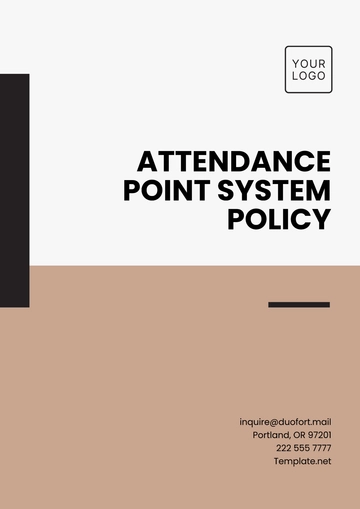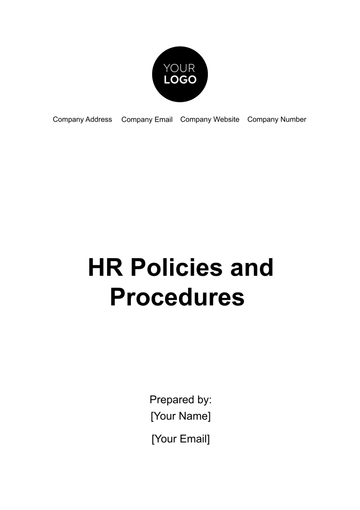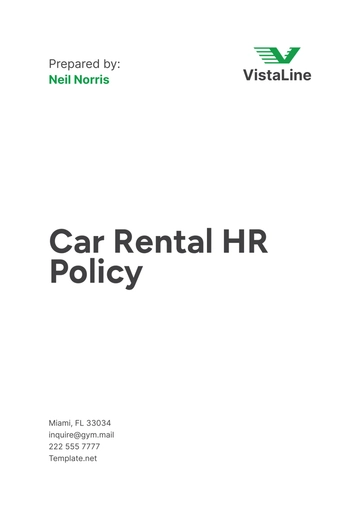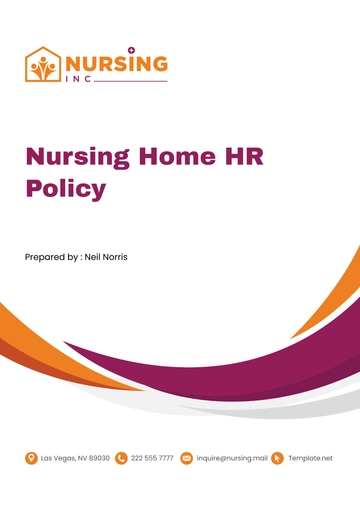Free Printable HR Policy

I. Introduction
A. Purpose of the HR Policy
The purpose of this Human Resources (HR) policy document is to establish clear guidelines and standards for managing and supporting the workforce at [Your Company Name]. This policy serves as a comprehensive guide for all employees, including management, staff, and stakeholders, to ensure that HR practices align with the company’s mission, vision, and values. It is designed to promote a fair, respectful, and inclusive workplace, which will foster a positive work environment and contribute to the overall success of the company as we advance into the year 2050 and beyond.
B. Scope of the HR Policy
This HR policy applies to all employees of [Your Company Name], including full-time, part-time, temporary, and contract staff, across all locations and departments. The policy covers a wide range of HR-related topics, including but not limited to recruitment, onboarding, employee conduct, compensation, benefits, performance management, training, development, and termination. As [Your Company Name] continues to grow and evolve in the coming decades, this policy will be periodically reviewed and updated to reflect changes in legislation, best practices, and organizational needs.
II. Employment Practices
A. Equal Employment Opportunity
[Your Company Name] is committed to providing equal employment opportunities to all employees and applicants for employment. We do not discriminate based on race, color, religion, sex, gender identity, sexual orientation, national origin, age, disability, genetic information, marital status, veteran status, or any other characteristic protected by law. This commitment to diversity and inclusion is a cornerstone of our HR strategy and is essential to maintaining a dynamic and innovative workforce that can adapt to the challenges of the future.
B. Recruitment and Selection
Recruitment Process
The recruitment process at [Your Company Name] is designed to attract and hire the best talent available, ensuring that all candidates are evaluated based on their qualifications, experience, and potential contribution to the company. The process includes job postings, candidate screening, interviews, and reference checks, all of which are conducted in a fair and transparent manner.Selection Criteria
The selection criteria for each position are clearly defined in the job description and are based on the essential skills, qualifications, and experience required for the role. In addition to technical expertise, [Your Company Name] values qualities such as leadership, teamwork, problem-solving abilities, and a commitment to continuous learning.
C. Onboarding and Orientation
Onboarding Program
The onboarding program at [Your Company Name] is designed to help new employees integrate smoothly into the company and become productive members of the team as quickly as possible. This program includes an introduction to the company’s culture, values, and policies, as well as training on specific job responsibilities and performance expectations. The onboarding process is tailored to the needs of each new hire, with a focus on providing the support and resources needed for a successful start.Orientation Sessions
Orientation sessions are held regularly to welcome new employees and provide them with an overview of the company’s operations, key personnel, and strategic goals. These sessions also include training on important topics such as workplace safety, data security, and ethical conduct. New hires are encouraged to ask questions and seek clarification on any aspect of their role or the company during these sessions.
III. Employee Conduct and Discipline
A. Code of Conduct
The Code of Conduct at [Your Company Name] sets out the standards of behavior expected from all employees. It reflects the company’s commitment to maintaining a professional, ethical, and respectful workplace where all employees can thrive. The Code of Conduct covers a wide range of topics, including but not limited to integrity, confidentiality, conflict of interest, and appropriate use of company resources.
B. Disciplinary Procedures
Types of Misconduct
Misconduct at [Your Company Name] is categorized into minor, major, and gross misconduct, with each category carrying different levels of disciplinary action. Examples of minor misconduct include tardiness, minor breaches of company policy, and unprofessional behavior. Major misconduct may involve significant violations of company policy, such as insubordination, harassment, or discrimination. Gross misconduct includes severe violations, such as theft, violence, or serious breaches of confidentiality.Disciplinary Actions
Disciplinary actions at [Your Company Name] range from verbal warnings and written reprimands to suspension and termination, depending on the severity of the misconduct. All disciplinary actions are documented and are subject to review by the HR department to ensure fairness and consistency. Employees have the right to appeal any disciplinary action taken against them, and the company is committed to resolving such matters in a timely and equitable manner.
C. Grievance Procedures
Filing a Grievance
Employees at [Your Company Name] have the right to file a grievance if they believe they have been treated unfairly or if they have concerns about workplace conditions or management practices. The grievance procedure is designed to provide a clear and confidential process for addressing such concerns, with the goal of resolving issues in a fair and timely manner.Grievance Resolution
The HR department is responsible for investigating and resolving grievances in accordance with company policy and applicable laws. This process may involve mediation, interviews with involved parties, and a review of relevant documentation. The outcome of the grievance process will be communicated to the employee in writing, along with any actions taken to address the issue.
IV. Compensation and Benefits
A. Compensation Structure
Salary Framework
[Your Company Name] offers a competitive salary structure that is designed to attract, retain, and motivate top talent. Salaries are determined based on factors such as job level, market benchmarks, individual performance, and the company’s financial performance. The salary framework is reviewed annually to ensure it remains competitive and aligned with industry standards.Job Level
Minimum Salary (USD)
Maximum Salary (USD)
Entry-Level
$50,000
$70,000
Mid-Level
$70,000
$100,000
Senior-Level
$100,000
$150,000
Executive-Level
$150,000
$250,000
Bonus and Incentives
In addition to base salaries, [Your Company Name] offers performance-based bonuses and incentives to reward employees for their contributions to the company’s success. These bonuses are tied to individual, team, and company performance metrics and are designed to align employee interests with the company’s strategic goals.
B. Employee Benefits
Health and Wellness
[Your Company Name] is committed to supporting the health and well-being of its employees by offering a comprehensive benefits package that includes medical, dental, and vision insurance, as well as wellness programs such as gym memberships and mental health support. Employees are encouraged to take advantage of these resources to maintain a healthy work-life balance.Retirement Plans
To help employees plan for their future, [Your Company Name] offers a generous retirement savings plan with company-matching contributions. Employees can choose from a range of investment options and have access to financial planning services to help them achieve their retirement goals.Retirement Plan Option
Company Match Percentage
Employee Contribution Limit (USD)
401(k) Plan
5%
$19,500
Roth 401(k)
5%
$19,500
Pension Plan
10%
N/A
C. Leave Policies
Vacation Leave
Employees at [Your Company Name] are entitled to paid vacation leave, which is accrued based on years of service. The company recognizes the importance of taking time off to rest and recharge and encourages employees to use their vacation leave to maintain a healthy work-life balance. The vacation leave policy is designed to be flexible and accommodating, allowing employees to plan their time off in a way that suits their personal needs and preferences.Years of Service
Annual Vacation Days
0-5 Years
15 Days
6-10 Years
20 Days
11+ Years
25 Days
Sick Leave
[Your Company Name] provides paid sick leave to employees who are unable to work due to illness or injury. Sick leave can also be used to care for an immediate family member who is ill. The company understands that health issues can arise unexpectedly, and the sick leave policy is designed to provide employees with the support they need during such times.Parental Leave
In recognition of the importance of family, [Your Company Name] offers parental leave to both mothers and fathers following the birth or adoption of a child. This leave is fully paid and is intended to give parents the time they need to bond with their new child and adjust to their new family responsibilities. The policy reflects the company’s commitment to supporting employees in all aspects of their lives, both personal and professional.Type of Parental Leave
Leave Duration (Weeks)
Full Pay (Yes/No)
Maternity Leave
16 Weeks
Yes
Paternity Leave
8 Weeks
Yes
Adoption Leave
12 Weeks
Yes
V. Performance Management
A. Performance Appraisals
Annual Review Process
The performance appraisal process at [Your Company Name] is designed to provide employees with constructive feedback on their job performance and to identify areas for development and growth. The annual review includes a self-assessment, peer reviews, and a formal evaluation by the employee’s supervisor. The results of the appraisal are used to inform decisions about promotions, salary adjustments, and professional development opportunities.Goal Setting and Development Plans
As part of the performance management process, employees at [Your Company Name] work with their supervisors to set specific, measurable, achievable, relevant, and time-bound (SMART) goals. These goals are aligned with the company’s strategic objectives and are reviewed regularly to ensure progress is being made. In addition, employees are encouraged to create development plans that outline the skills and knowledge they wish to acquire in order to advance their careers.
B. Training and Development
Employee Training Programs
[Your Company Name] is committed to the continuous professional development of its employees. The company offers a variety of training programs, both in-house and external, to help employees acquire new skills and stay current with industry trends. These programs cover a wide range of topics, including technical skills, leadership development, and compliance training.Tuition Reimbursement
To support lifelong learning, [Your Company Name] offers a tuition reimbursement program that provides financial assistance to employees who wish to pursue higher education or professional certifications. The program covers tuition, books, and related expenses, and is available to all full-time employees who have been with the company for at least one year.Program Eligibility
Reimbursement Limit (USD)
Full-Time Employees
$10,000 per year
Part-Time Employees
$5,000 per year
Certification Programs
$2,000 per certification
VI. Workplace Safety and Health
A. Occupational Health and Safety
[Your Company Name] is committed to providing a safe and healthy work environment for all employees. The company adheres to all applicable occupational health and safety regulations and has implemented comprehensive safety policies and procedures to minimize the risk of workplace accidents and injuries. Employees are required to follow these safety protocols at all times and to report any hazards or unsafe conditions to their supervisor immediately.
B. Health and Wellness Initiatives
Wellness Programs
[Your Company Name] offers a variety of wellness programs designed to promote the physical and mental well-being of employees. These programs include fitness challenges, health screenings, stress management workshops, and access to counseling services. The company recognizes that employee well-being is essential to maintaining high levels of productivity and job satisfaction, and it is committed to providing the resources needed to support a healthy workforce.Ergonomic Assessments
To prevent work-related musculoskeletal disorders, [Your Company Name] conducts ergonomic assessments of workstations and provides employees with the necessary equipment and training to maintain proper posture and reduce strain. Employees are encouraged to take regular breaks and to report any discomfort or pain that may be related to their work environment.
VII. Employee Relations
A. Communication and Feedback
Open-Door Policy
[Your Company Name] promotes an open-door policy that encourages employees to communicate freely with management about any concerns, suggestions, or ideas they may have. This policy is designed to foster a culture of transparency and trust, where employees feel valued and heard. The company believes that open communication is key to maintaining a positive work environment and to identifying and addressing potential issues before they escalate.Employee Surveys
Regular employee surveys are conducted to gather feedback on various aspects of the workplace, including job satisfaction, management effectiveness, and company culture. The results of these surveys are used to identify areas for improvement and to develop action plans that address employee concerns. The company is committed to making data-driven decisions that enhance the employee experience and support the company’s long-term success.
B. Employee Recognition
Recognition Programs
[Your Company Name] believes in recognizing and rewarding employees for their hard work, dedication, and contributions to the company. The recognition program includes formal awards, such as Employee of the Month, as well as informal recognition, such as peer-to-peer shout-outs and thank-you notes. The company understands that recognition is a powerful motivator and is committed to creating a culture where employees feel appreciated and valued.Service Awards
To honor long-term commitment, [Your Company Name] presents service awards to employees who reach significant milestones in their careers. These awards are given at intervals such as 5, 10, 15, and 20 years of service and may include a combination of gifts, bonuses, and public recognition. The company values the loyalty and experience of its long-serving employees and seeks to celebrate their contributions in a meaningful way.
VIII. Termination of Employment
A. Voluntary Termination
Resignation Process
Employees who choose to resign from their position at [Your Company Name] are required to provide a written notice of resignation at least two weeks in advance. The resignation process includes an exit interview, during which the employee has the opportunity to provide feedback on their experience with the company. The company values this feedback and uses it to identify potential areas for improvement.Exit Interviews
Exit interviews are conducted by the HR department and are designed to gather information on why the employee is leaving, what the company can do to improve retention, and what the employee’s future plans are. The company views these interviews as an important tool for understanding employee turnover and for making data-driven decisions to improve the work environment.
B. Involuntary Termination
Termination for Cause
In cases where an employee’s conduct or performance does not meet the standards expected by [Your Company Name], the company may choose to terminate the employee’s employment for cause. This may include violations of the Code of Conduct, repeated poor performance, or other serious issues. Termination for cause is considered a last resort, and the company is committed to providing employees with the support and resources they need to improve before taking this step.Severance Packages
[Your Company Name] may offer severance packages to employees who are involuntarily terminated due to reasons such as downsizing, restructuring, or other business needs. Severance packages may include a lump-sum payment, continuation of benefits, and outplacement services to help the employee transition to a new job. The company is committed to treating all employees with dignity and respect, even in cases of involuntary termination.
IX. Policy Review and Updates
A. Regular Review Process
The HR policy at [Your Company Name] is reviewed on an annual basis to ensure that it remains current and relevant in light of changes in legislation, best practices, and the company’s strategic goals. The review process involves input from key stakeholders, including HR professionals, legal advisors, and senior management. The company is committed to maintaining a policy that supports a positive and productive work environment for all employees.
B. Employee Involvement
[Your Company Name] recognizes the importance of involving employees in the policy review process. Employees are encouraged to provide feedback on the HR policy and to suggest areas for improvement. The company values this input and considers it an essential part of creating a policy that reflects the needs and concerns of the workforce.
C. Communication of Updates
Any updates or changes to the HR policy will be communicated to all employees in a timely manner. This may include company-wide emails, updates to the employee handbook, and training sessions to ensure that all employees understand the changes and how they affect their roles and responsibilities. The company is committed to transparency and to keeping employees informed about important policy updates.
X. Conclusion
The HR policy of [Your Company Name] is a living document that reflects the company’s commitment to creating a fair, respectful, and inclusive workplace. As we move forward into 2050 and beyond, the company will continue to adapt and evolve its HR practices to meet the challenges of the future while staying true to its core values. This policy is a key part of our strategy to attract, retain, and develop the best talent in the industry, and to ensure that [Your Company Name] remains a great place to work for all employees.
- 100% Customizable, free editor
- Access 1 Million+ Templates, photo’s & graphics
- Download or share as a template
- Click and replace photos, graphics, text, backgrounds
- Resize, crop, AI write & more
- Access advanced editor
Create comprehensive and clear HR policies with the HR Policy Template from Template.net. This customizable template is designed to help you outline your organization’s policies effectively. Editable in our AI Editor Tool, it ensures you can tailor policies to meet your specific needs. Download now and establish robust HR guidelines!
You may also like
- HR Policy
- Restaurant Policy
- Company Policy
- Accounting Policies and Procedures
- Website Policy
- Privacy Policy
- Safety Policy
- School Policy
- IT and Software Policy
- Law Firm Policy
- Construction Policy
- Interior Design Policy
- Travel Agency Policy
- Education Academic Policy
- Security Policy
- Real Estate Policy
- Expense Policy
- Software Policy





























